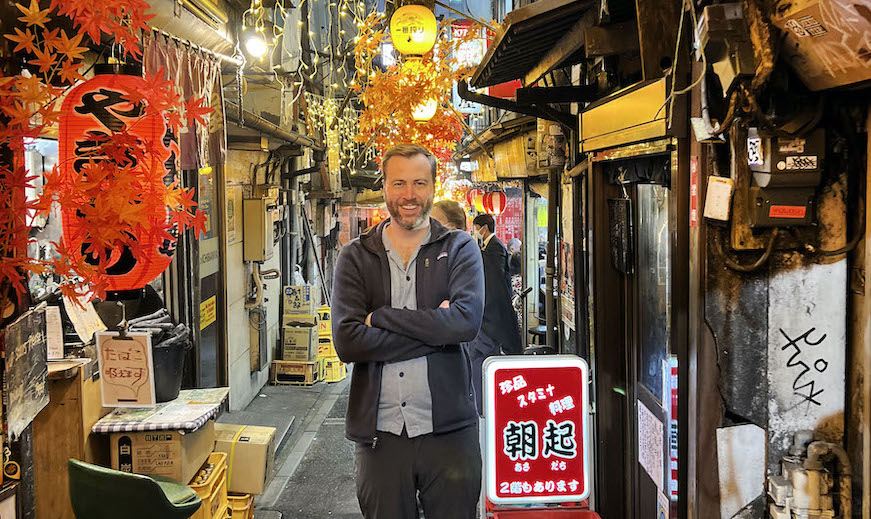
Improv Ambassador Byron Kennerly recovers from jet lag on Omoide Yokocho, a colorful ally close to the Shinjuku railway station. Known for cheap drinks and grilled skewers of yakitori, the street was home to Tokyo’s black market after World War II. The area’s many watering holes and lack of public restrooms earned it the nickname “piss alley.” Redeveloped following a fire in the 1990s, it today looks much as it did during the Shōwa era of Emperor Hirohito.
By Byron Kennerly
No joke, I’m embarking on a quest to perform an improv comedy show in every country in the world. First stop, Japan. Improv is a chaotic, spur-of-the-moment comedy form that relies on the audience yelling out suggestions. Japan is harmonious, well-planned, and exceedingly polite. What could go wrong?
Show 1: Tokyo, Japan
Two hours after landing at Narita Airport I head to Golden Gai, the home of 200 micro bars stuffed into three blocks of rundown two-story buildings in the Shinjuku neighborhood. I enter the first spot that allows Westerners (some don’t) and order a Japanese whisky. The bartender, Hiroshi, intrigued by this jet lagged American in his bar, asks what my deal is.
“I’m here to do an improv comedy show.” He stares at me blankly for a moment before asking “What’s improv?” It’s a question I better get used to answering.
I tell Hiroshi that improv is an entirely made-up comedy show based on audience suggestions. There are two main kinds of improv: short and long form. Short form is the most well-known. It consists of a series of three-to-five-minute games that each have unique rules or quirks. For example, in the game “ABC,” every line in the scene must start with the next letter in the alphabet. A new game then begins with new rules and different audience suggestions.
Long form, on the other hand, simply gets one audience suggestion at the top of the show and the performers create an entire thirty-to-sixty-minute show based on that and other revelations made throughout the performance.
Hiroshi processes this and says, “That sounds fun. I’ll come to your show.” I’m delighted. My journey as the Improv Ambassador is off to a good start!
Three days later I head to Tokyo’s Ebisu neighborhood and enter a British Pub called What the Dickens! The wooden pillars and bottles of whisky behind the bar remind me of a British Frigate from the 1700s, which is fitting because tonight I’m performing with the Pirates of Tokyo Bay, an improv group consisting of Japanese, American, Singaporean, British, Hong Kong, and Swiss performers.
The Pirates perform bilingual short form shows, one game in English, the next in Japanese, and every game is explained to the audience in both languages before it starts. Even if you don’t understand both English and Japanese, you can sort of kind of follow what’s happening. Perfect for Japanese/English-speaking couples who can enjoy the show together.
Osaka is the comedy capital of Japan (Japan’s version of Saturday Night Live is based there) and audiences arrive at comedy shows ready to laugh. In Tokyo, audiences come in with the mentality of “you think you can make me laugh huh? Prove it.” No pressure.
As the crowd files into the pub, I’m nervous. Tonight is the first show on my global comedy adventure and I don’t speak the language half the show will be in. We warm up with the cast in a balcony dining area-turned-cramped-green room and my nerves immediately vanish. Improv warmup exercises are notoriously silly, and I immediately connect with the team.
Yo Ho Ho and a Bottle of Suntory
The pre-show music cranks up and one by one the Pirates are introduced. I hear my name and rush to the stage. The pub is PACKED but there’s no time to take it in, our opening musical dance number is beginning.
In the States, my shows don’t start with a rehearsed musical number, but in Japan starting with something familiar helps audiences feel comfortable. We are dancing and singing to a custom version of a Korenande Shoukai song, a popular Japanese puppet variety show. While the dance and chorus are planned, the verses, supplied by each cast member, are made up. The song is upbeat, sugary, energetic, and the crowd loves it.
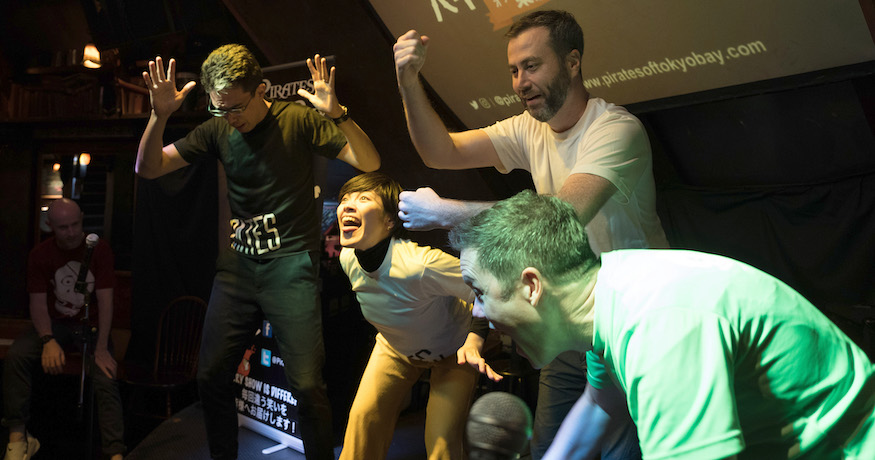
Ahoy, Matey! The Pirates of Tokyo Bay invite Byron Kennerly to join them in some unscripted Improv comedy. Photo by Kajetan Rodziewicz
The first game of the show is called “Two Lines” and takes advantage of the only two people in the room who don’t speak Japanese: Filipino Gabe Mercado and me. We’re each given two short phrases in Japanese and those are the only things Gabe and I can say. Our partner in the scene, an American named Bill, will only be speaking Japanese and maneuvering around our hilariously out-of-context phrases.
The suggestion given by the audience is “broken belt from drinking too much beer;” longer than usual but there are no wrong answers in improv. My Japanese phrases are mo I no (Are you done?) and yamete. The scene takes off, and Gabe goes for his belt, shouting his two phrases as Bill whirls around the stage spouting full Japanese sentences. I lie in wait, letting them have the focus until the perfect moment. Gabe turns to me, hands on belt and leading from the waist. I shout YAMETEEEEEEE with all my might. The crowd erupts in laughter. I didn’t know until after the game but yamete translates to “stop it.” Saying it when I did was the perfect accident, the kind that makes improv unlike any other art form in the world. The show only builds from there and after an hour and a half of making everything up, our international squad of sweaty improvisers clasp hands and take a bow.
You know you had a good show when the audience members want to take pictures with you afterward and we are happy to oblige. Hiroshi, the Golden Gai bartender, not only came to the show but also gave a glowing review: “I’d see that again.”
This was big. I now know that this crazy journey is possible, that I can make people laugh outside of my home country no matter how intimidating an audience might be.
Show 4: Baguio, Philippines
The mountainous Cordillera in Northern Luzon is one of the few regions never fully conquered by the colonial Spanish. Despite many attempts to control a land rich with gold, the Spanish were always thwarted by the Igorot indigenous people. It’s also where I’m performing my Philippines show. Luckily for me, the folks here now pride themselves on being very welcoming. It also doesn’t hurt that I’m funnier than a run-of-the-mill conquistador.
Their continued independence not only preserved Igorot culture, but also fostered an openness to offbeat performance art. Nowhere is this truer than Baguio, a town 155 miles north of Manilla. Baguio even has a yearly gong festival, so I’m pretty sure my improv show won’t be the loudest performance they’ve encountered recently.
Filipinos are somewhat familiar with improv and claim they were the first Asians to embrace unscripted comedy performances.
Remember Gabe Mercado from the show in Tokyo? In 2002 he co-founded SPIT Manila (Silly People’s Improv Theater), one of Asia’s longest-running improv groups. He invited me to perform with him in Baguio, where the climate is cooler and the atmosphere more relaxed than in Manila.
Two person shows take more energy and rely heavily on audience participation. And Gabe and I are about to perform for an entire audience that has never seen an improv show. Mercado is the co-founder of Vivita Philippines, an extension of Vivita, a Japanese-originated seed accelerator for kids. Think after-school education meets Shark Tank (without the teeth). They have a great space called Vivistop in Baguio. Our venue will be a gorgeous century-old house with a library, cafe, project working area, and terrific outdoor space, where we’ll be performing.
Any touring improviser will warn you against performing outside, and I’m no different. It’s a terrible acoustic environment, fraught with possible distractions and generally to be avoided unless conditions are perfect. Today they are!
There are microphones, a stage, proper seating and an attentive audience. The most important key to improv success is the crowd, and today we’ve got a good one. Almost everyone remains after the Vivita event, including many of the kids who just presented their startup ideas.
We kick off the show with an improvised poetry jam. The suggestion is “Queso de Bola” (ball of cheese), a famous brand in Luzon and a longtime Philippines Christmas tradition. Between my rhyme about passing dairy gas (a comedy staple worldwide) and Gabe doing lines in Tagalog, we are off to a hot start.
We soon discover that this Filipino audience has a global sense of humor and is primed for jokes about tech entrepreneur Elon Musk. In the game “Pillars,” Gabe and I play disgruntled Tesla employees complaining about our larger-than-life boss. The eviler we make Elon seem, the more the crowd laughs. Turns out that poking fun at Musk is enjoyed universally. Poor guy just can’t catch a break.
But now, a major tipping point: our first audience participation game. While no one in the audience has seen improv before, we have a secret weapon lurking amongst the crowd. The kids. They’re eager to volunteer, undaunted by stage fright, and have minds full of hilarious thoughts.
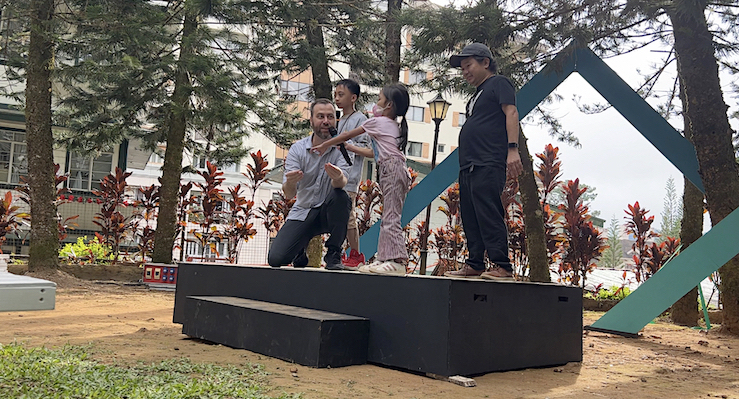
In Baguio, Byron Kennerly and Gabe Mercado conduct an improv comedy workshop for young children attending a program to help them develop entrepreneurial skills.
Kids Say the Darndest Things
I ask for volunteers from the audience and two small hands shoot up. Gabe and I are joined on stage by Mazzi, an energetic eleven-year-old and Alsea, a petite girl who can’t be more than seven.
We are playing the game “Pan Left/Pan Right” in which we get four suggestions and do four scenes that rotate in a square. It’s like switching the channels on a TV except, you know, it’s improv. The audience suggestions are Antarctica (for my scene with Mazzi) and Sadness (for my scene with Alsea).
I start with Mazzi who immediately makes the excellent choice of playing a penguin. I’m a human trying to become part of the penguin kingdom. The audience loves it.
The next scene is with Alsea and because she is so small, I decide to make her my mom and give her elevated status. I come to her with a failed test from school and, per the suggestion, I’m “sad”. Alsea is nervous and doesn’t say anything, so I complain about her giving me the silent treatment and ask if she’s proud of me. Alsea waits a beat and then says in character as my mom…”Sorry”. The audience reacts with a mix of raucous laughter and Awws of sympathy. When you can get a genuine reaction like that from the audience, improv is working.
Alsea clearly has a bright future in make-em-ups. The audience is won over. Gabe and I finish the show with a long form set based on Star Wars. We get out-of-this-world applause from the crowd that likes improv so much that they invite me to a wedding that’s happening right after the show. A Kankanaey wedding.
The Kankanaey are a subset of the Igorot indigenous group, and they do weddings a little differently. Our squad hops out of a Jeepney (a legendary mode of Filipino transportation that combines a jeep, taxi, limousine, and street art exhibit) and walk into day three (!) of the wedding. Upstairs is a traditional setup, with lots of white flowers, but downstairs is where the party is at. And the food. So. Much. Food.
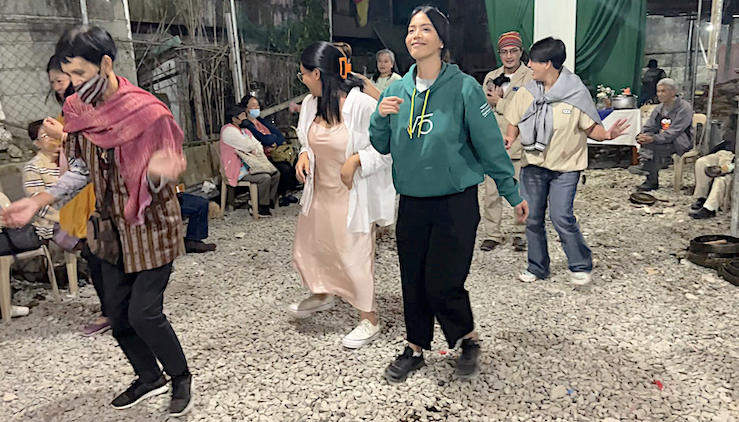
In the Philippine city of Baguio, the Kankanaey people, who belong to the Igorot indigenous group, stage elaborate weddings to which the whole town is invited. And no wedding is complete without a country music Line Dance.
Party Hearty
What sets Kankanaey weddings apart (besides the length) is that it is an open invitation. Everyone in the town is expected to attend at some point and the families are preparing enough food for 3,000 people. That’s why no one gives me a second glance when I load my plate with beef, rice and noodles despite looking very different than everyone else at the event.
As I sip on chunky mulled wine (it’s … good) I get the biggest surprise of the evening when the party morphs into an old-fashioned country western jamboree. Indeed, while maintaining their own culture, the Kankanaey still embrace a few American customs. Namely, country music, cowboy hats and of course…Line Dancing.
A country song starts playing prompting the wedding party to hit the dance floor in rows and begin their choreographed sequences. As a guy who invents wild situations on a stage for a living, I couldn’t have made this up.
For the first time, I realize that this adventure will not only expand what I know to be possible on stage but off stage as well. I probably never would have come to Baguio or experienced this Kankanaey wedding party if I hadn’t taken the leap of giving up what was comfortable and safe. Time to borrow a cowboy hat and start dancing.
Show 9: Singapore
Comedy and bureaucracy are not a natural pairing. Normally, for either to be successful, one needs to be devoid of the other. Despite this, sternly managed Singapore is something of an improv powerhouse. I’m performing with Improvanopolis. The group was one of the first to do improv shows in the Little Red Dot.
But first I must complete a sheaf of questionnaires to receive an Arts Entertainment License from the government’s Infocomm Media Development Authority. The Haque Centre of Acting & Creativity, a drama school and creative space in the Little India neighborhood where I’ll appear and also conduct a comedy workshop requires more paperwork. Fortunately, permission to be creative eventually is granted.
The Haque Centre is cozy but with space, professional lighting and a specific stage area. Despite my misgivings about the hoops that needed jumping through to get here, I can’t argue with the results. Not only is the place jammed, but the audience is raring to laugh at whatever we do on stage.
Chain Smoking Crustaceans
In a game called “New Choice,” Irene Malone, a film teacher from New Zealand, and I play chain smoking crabs obsessed with increasing our chances in Singapore’s Housing and Development Board lottery. The HDB oversees Singapore’s public housing, and its units are much sought after. The audience immediately lights up, clearly responding to the surreality of this very tangible topic being debated by talking crabs. It’s a moment that can only happen on an improv stage and laughs in the room are at their loudest.
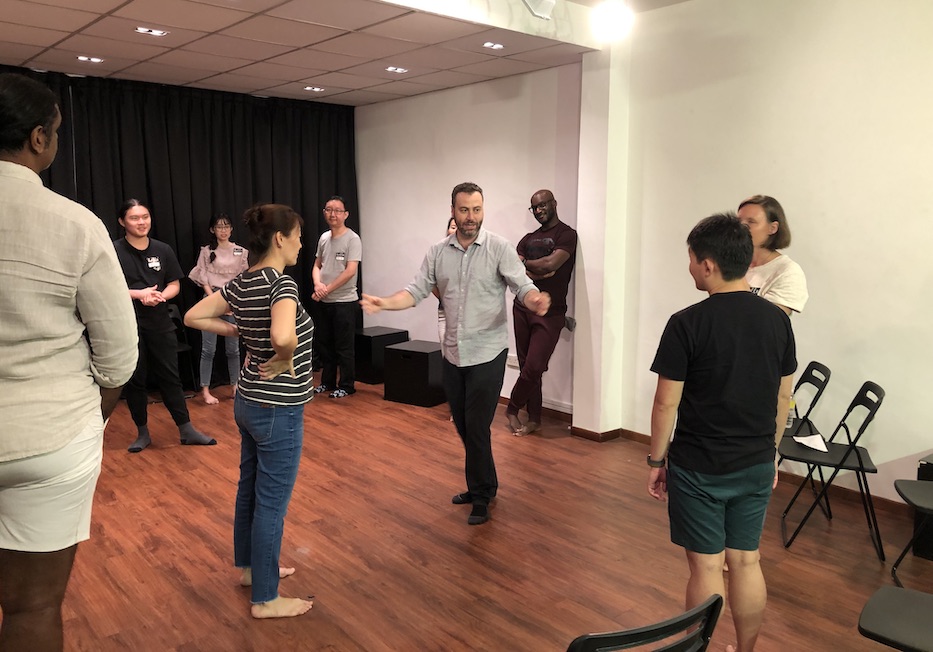
Improv Ambassador Byron Kennerly conducts a workshop in Singapore for people interested in learning about unscripted, impromptu improv comedy. Photo by Pavan Singh
The momentum of the night carries on to my improv workshop two days later. Many people attend because they loved the show; others join because of that long questionnaire I filled out months before. Because of that form, they know what to expect and are excited to expand their performance skills. They’re a great group and quickly grasp the improv methods I impart over the next three hours. Maybe art COULD use a little more red tape to get the creativity flowing…but then again, No. Much like the rest of this unique city state, the scrupulous methods that are so successful here probably can’t be replicated anywhere else. And that’s what makes Singapore Singapore.
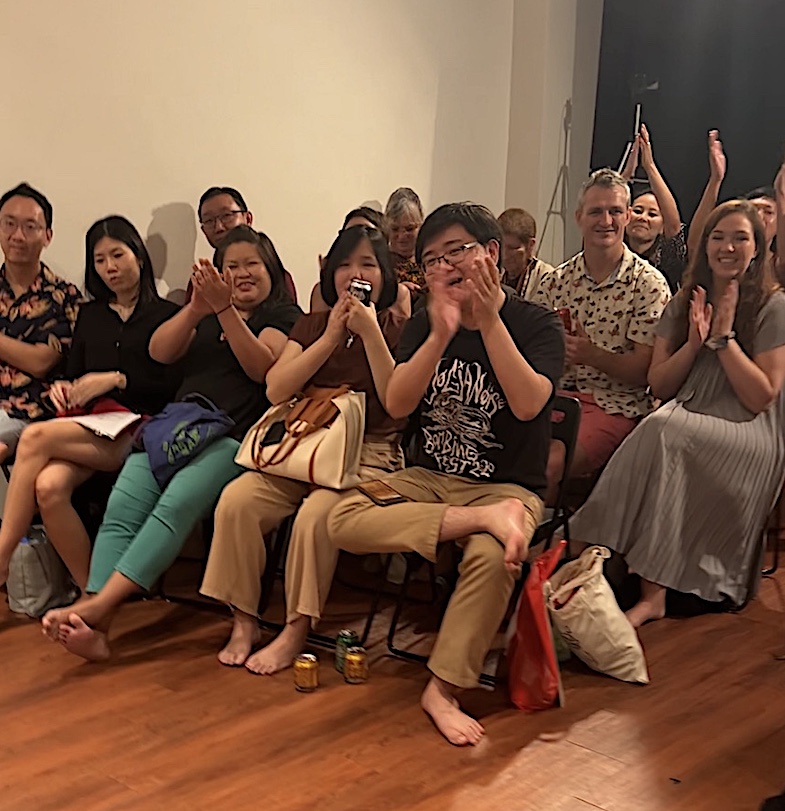
Part of a much larger audience in Singapore relaxes and gets comfortable while they watch their friends and relatives learn comedy skills at a workshop conducted by Improv Ambassador Byron Kennerly. Photo by Byron Kennerly
I wasn’t sure this could be done. The Improv Ambassador? When I started this quest to perform an improv comedy show in every country in the world, I was nervous and worried I’d made a mistake. After six months and eleven shows across eleven different Asian countries, I no longer think the journey is crazy. Eleven countries down one hundred and eighty-six to go. Impossible? YAMETE! ![]()
Byron Kennerly is a touring comedian from Los Angeles currently on a quest to perform an improv comedy show in every country in the world. Follow the global adventures of the Improv Ambassador on Instagram.

